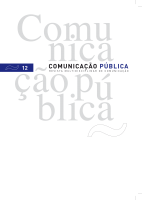Public Relations
Communication, Organizations and Society
DOI:
https://doi.org/10.4000/cp.112Keywords:
public relations, profession, education, interviews, PortugalAbstract
This article aims to justify the importance of public relations profession in contemporary society, highlighting education, skills, values, functions, services provided by public relations consultant, as well as the need for association and understanding of digital communication, assumed to be its big trend. Based on a literature review and ten semi-structured interviews to Portuguese consultants, affiliate members of APECOM, we conclude that the sector is increasingly recognized in Portugal, requiring, however, the dynamics of their association to promote the connection of practice to academia.
Downloads
References
Bernays, E. L. (1928), Crystallizing Public Opinion, Nova Iorque, Boni and Liveright.
Botan, C. H., & Taylor, M. (2004), "Public Relations: state of the field", Journal of Communication, Dezembro, pp. 645-661. DOI : 10.1111/j.1460-2466.2004.tb02649.x good / bad
Bowen, S. A. (2009), "All glamour, no substance: How public relations majors and potential majors in an exemplar program view the industry and function", Public Relations Review, 35, pp. 402-410. DOI : 10.1016/j.pubrev.2009.05.018 good / bad
Coombs, W. T., & Holladay, S. J. (2007), It’s Not Just PR, Malden, Blackwell Publishing.
Cornelissen, J. P. (2000), "Toward an understanding of the use of academic theories in public relations practice", Public Relations Review, 26(3), pp. 315-326. DOI : 10.1016/S0363-8111(00)00050-3 good / bad
Dozier, D., & Broom, G. (1995), "Evolution of the manager role in public relations practice", Journal of Public Relations Research, 7(1), pp. 3-26. DOI : 10.1207/s1532754xjprr0701_02 good / bad
Fawkes, J. (2004), "What is public relations?", in A. Theaker (Ed.), The Public Relations Handbook, 2.ª ed., pp. 3-17, Oxfordshire, Routledge.
Fuchs, C. (2008), Internet and Society: Social Theory in the Information Age, Nova Iorque, Routledge.
Gonçalves, G. (2009), "Strengths and Weaknesses of Public Relations Education in Portugal", Estudos em Comunicação, 6, pp. 37-54.
Greenwood, C. A. (2010), "Evolutionary Theory: the missing link for conceptualizing public relations", Journal of Public Relations Research, 22(4), pp. 456-476. DOI : 10.1080/10627261003801438 good / bad
Grunig, J. E.; Hunt, T. (1984), Managing Public Relations, Nova Iorque, Holt, Rinehart & Winston.
Grunig, L. A., Grunig, J. E., & Dozier, D. M. (2002), Excellent Public Relations and Effective Organizations. A Study of Communication Management in Three Countries, Nova Iorque, Routledge.
Hunt, T., & Grunig, J. E. (1994), Public Relations Techniques, Fort Worth, Harcourt Brace College Publishers.
Pasadeos, Y., Berger, B., & Renfro, R. B. (2010), "Public Relations as a maturing discipline: an update on research networks", Journal of Public Relations Research, 22(2), pp. 136-158. DOI : 10.1080/10627261003601390 good / bad
Póvoas, R. (2009), Relações Públicas sem Croquete. Lisboa, Gestão Plus Edições.
Seib, P., & Fitzpatrick, K. (1995), Public Relations Ethics, Florida, Harcourt Brace and Company.
Sievert, Holger (2009), “Some ideas for new Systematics” Input to the Round Table “PR practices and qualifications”, EUPRERA 2009 – Bucareste, 23-26 Setembro.
Sisco, H. F., Collins, E. L., & Zoch, L. M. (2011), "Breadth or depth? A content analysis of the use of public relations theory", Public Relations Review, 37, pp. 145-150. DOI : 10.1016/j.pubrev.2010.10.006 good / bad
SOPCOM (outubro de 2010), Editorial: A nossa área científica. Consulta a 2 de dezembro de 2011. URL: http://www.sopcom.pt/Newsletter/201010-Sopcom.html.
Sriramesh, K., & Hornaman, L. B. (2006), "Public Relations as a Profession: an analysis of curricular content in the United States", Journal of Creative Communication, 1(2), pp. 155-172. DOI : 10.1177/097325860600100202 good / bad
Tench, R., & Yoemans, L. (2009), Exploring Public Relations, 2.ª ed., Londres, Financial Times/Prentice Hall.
Weaver, C. K. (2001), "Dressing for Batle in the New Global Economy: putting Power, Identity, and Discourse into Public Relations Theory", Management Communication Quarterly, 15(2), pp. 279-288.
White, C., & Park, J. (2010), “Public perceptions of public relations”, Public Relations Review, 36, pp. 319-324. DOI : 10.1016/j.pubrev.2010.09.002 good / bad
Zerfass, A. et al. (2009), European Communication Monitor 2009. Trends in Communication Management and Public Relations – Results and Implications. Bruxelas, Leipzig: Euprera/University of Leipzig (disponível em: www.communicationmonitor.eu), última consulta a 12 de outubro de 2011.
Downloads
Published
Issue
Section
License
Copyright (c) 2012 Direitos do Autor (c) 2012

This work is licensed under a Creative Commons Attribution-NonCommercial 4.0 International License.
Os conteúdos da Comunicação Pública estão licenciados com uma licença Creative Commons - Atribuição-NãoComercial 4.0 Internacional.


